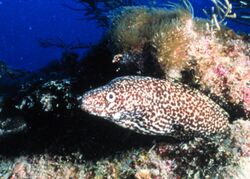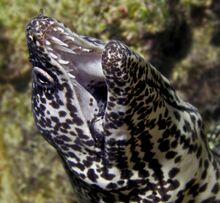Biology:Spotted moray
| Spotted moray | |
|---|---|

| |
| Scientific classification | |
| Domain: | Eukaryota |
| Kingdom: | Animalia |
| Phylum: | Chordata |
| Class: | Actinopterygii |
| Order: | Anguilliformes |
| Family: | Muraenidae |
| Genus: | Gymnothorax |
| Species: | G. moringa
|
| Binomial name | |
| Gymnothorax moringa Cuvier, 1829
| |
The spotted moray (Gymnothorax moringa) is a medium to large moray eel. Other common names include conger, spotted eel, red moray, speckled moray, white cong, white jawed moray, white-chinned moray and white-jawed moray eel. Spotted eels have a long snake-like body, white or pale yellow in general with small overlapping reddish brown to dark-brown spots. They are commonly 60 cm (24 in) in length and can grow up to 2 m (6.6 ft), weighing 2.51 kg (5.5 lb).[2][3] They inhabit the Western Atlantic Ocean from North Carolina and Bermuda to Brazil , including the Gulf of Mexico and the Caribbean. They are also found around the Mid- and Eastern Atlantic islands as far south as St Helena. They are typically found anywhere from the surface to a depth of 200 m (660 ft).
Spotted morays are solitary animals, and usually hide in narrow crevices and holes in reef structures with only their heads peeking out. They are active during the day, feeding on crustaceans, molluscs[4] and fish at or near the sea bottom. Their bite can be dangerous to humans due to damage caused by the pull-back effect of the bite itself, and potential toxins that may be released into the wound.[5][6] There is a minor fishery for spotted eels, and they are also kept in aquariums until their size makes it impractical to do so.
Notes
- ↑ Smith, D.G.; McCosker, J. (2015). "Gymnothorax moringa". IUCN Red List of Threatened Species 2015: e.T195762A2414442. doi:10.2305/IUCN.UK.2015-2.RLTS.T195762A2414442.en. https://www.iucnredlist.org/species/195762/2414442. Retrieved 14 January 2022.
- ↑ "Spotted Moray Eels, Gymnothorax moringa". The Marine Bio Conservation Society. http://marinebio.org/species.asp?id=928. Retrieved 2015-11-01.
- ↑ "Gymnothorax moringa, Spotted moray : fisheries, aquarium". Fishbase.org.cn. http://fishbase.org.cn/Summary/SpeciesSummary.php?ID=7547&genusname=Gymnothorax&speciesname=moringa. Retrieved 2011-04-14.
- ↑ https://sta.uwi.edu/fst/lifesciences/sites/default/files/lifesciences/documents/ogatt/Gymnothorax_moringa%20-%20Spotted%20Moray.pdf [bare URL PDF]
- ↑ Marco Lichtenberger (September 2007). "Moray Eels Bite—But Are They Poisonous?". Tropical Fish Hobbyist. http://www.tfhmagazine.com/details/articles/moray-eels-bitebut-are-they-poisonous-full-article.htm. Retrieved November 1, 2015.
- ↑ "The Emergency Management of Moray Eel Bites". Annals of Emergency Medicine 21 (2): 212–216. February 1992. doi:10.1016/s0196-0644(05)80169-6. PMID 1739216.
References
- "Gymnothorax moringa". Integrated Taxonomic Information System. https://www.itis.gov/servlet/SingleRpt/SingleRpt?search_topic=TSN&search_value=161188. Retrieved 19 March 2006.
- Froese, Rainer and Pauly, Daniel, eds. (2005). "Gymnothorax moringa" in FishBase. 10 2005 version.
External links
- Species account from FishBase
- Photos of Spotted moray on Sealife Collection
Wikidata ☰ Q1498026 entry
 |



